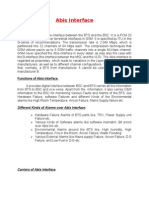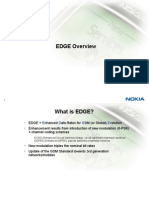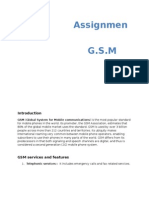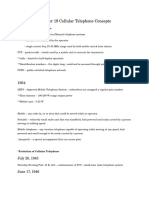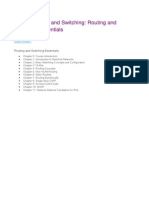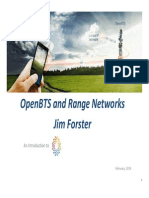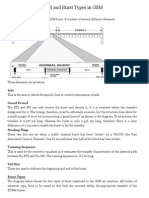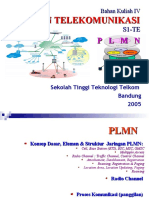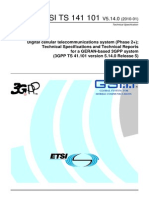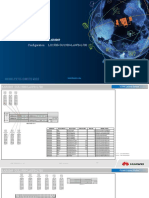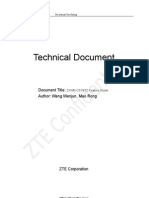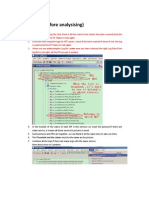GSM Technology
GSM Technology
Uploaded by
rgkripaCopyright:
Available Formats
GSM Technology
GSM Technology
Uploaded by
rgkripaOriginal Title
Copyright
Available Formats
Share this document
Did you find this document useful?
Is this content inappropriate?
Copyright:
Available Formats
GSM Technology
GSM Technology
Uploaded by
rgkripaCopyright:
Available Formats
GSM Technology Seminar Report ‘03
INTRODUCTION
The development of GSM started in 1982 when a study group ‘Group
Special Mobile’ was formed during Conference of European Posts and
Telegraphs (CEPT) this group was to develop a Pan-European public
cellular system in the 900 MHz range. Some of the basic criteria for their
proposed system were:
• Good subjective speech quality
• ISDN compatibility
• Spectral efficiency
• Support for international roaming
• Support for range of new services and facilities
In 1989, GSM responsibility was transferred to European
Telecommunication Standards Institute (ETSI) and commercial service was
started in mid 1991. Although GSM was standardized in Europe, now it is
operational in other continents also. The acronym GSM now aptly stands
for Global System for Mobile Communication.
CELLULAR CONCEPT
Cellular radio was devised in order to make better use of limited
resource of Radio Spectrum. Each Megahertz of spectrum will only support
a comparatively a small number of simultaneous conversations and the
same frequency must be reused many times in order to meet the capacity
needed for national or regional service. Cellular radio achieves this by
creating a honeycomb of cells over the region and assigning frequencies and
Dept. of CSE 1 MESCE Kuttippuram
GSM Technology Seminar Report ‘03
power levels in such away that the same frequency can be reused for
different conversation two or three cells away.
Although most of the countries in Europe had their own analogue
cellular system, they were not compatible with each other. So with the
development in Political, Commercial and Industrial areas there arose a
necessity for uniformity in cellular communication.
Dept. of CSE 2 MESCE Kuttippuram
GSM Technology Seminar Report ‘03
SYSTEM ARCHITECTURE
The functional architecture of a GSM system can be broadly classified
into
• Mobile Station (MS)
• Base Station Subsystem (BSS)
• Network and Switching Subsystem (NSS)
• Operation Subsystem (OSS)
The MS and the BSS communicate via the Um interface or radio link.
The BSS communicates with Mobile Service Switching Center across the A
interface.
MOBILE STATION
This may be a standalone piece of equipment for certain services or
support the connection of external terminals. The MS consists of the Mobile
Equipment (ME) and a Subscriber Identity Module (SIM).
The ME is uniquely identified by the International Mobile Equipment
Identity (IMEI), but it need not be personally assigned to one subscriber,
The SIM which is a smart card provides personal mobility and the user can
access the subscriber services. The subscriber can operate on any terminal
just by inserting the SIM card in that GSM terminal. SIM card contains the
International Mobile Subscriber Identity (IMSI) used to identify the
subscriber to the system, a secret key for authentication and other security
information’s. SIM card may be protected against unauthorized use by a
password.
Dept. of CSE 3 MESCE Kuttippuram
GSM Technology Seminar Report ‘03
BASE STATIONSUBSYSTEM
The BSS is composed of three parts, Base Transceiver Station (BTS)
and U3ase Station Controller (BSC). These two communicate across the
standardized Abis interface. The third part is Transcoder and Rate
Adaptation Unit (TRAU).
Base Transceiver Station:
This provides the GSM radio coverage within a cell. It comprises of
radio transmitting and receiving equipment and associated signal processing
units. This complements the radio features of ME.
Base Station Controller
This manages the radio resources for one or more BTS’s. It handles
radio channel set-up, Handovers and frequency hopping. Handovers
between BTS’s belonging to different BSC’s however can involve MSC’s
but are still managed by the original serving BSC. It controls the
transmission of information about Local Area Codes (LAC), signaling
channel configuration and information’s about neighboring cells.
Dept. of CSE 4 MESCE Kuttippuram
GSM Technology Seminar Report ‘03
Dept. of CSE 5 MESCE Kuttippuram
GSM Technology Seminar Report ‘03
Dept. of CSE 6 MESCE Kuttippuram
GSM Technology Seminar Report ‘03
Transcoder and Rate Adaptation Unit.
Dept. of CSE 7 MESCE Kuttippuram
GSM Technology Seminar Report ‘03
This is responsible for transcoding between GSM encoded speech at I
3KPS and fixed network speech at 64KPS. Similarly it performs rate
adaptation of GSM data services. Although it is a part of BSS, it is located
at MSC Sites. This is to benefit from the lower rate coding and cosequent
saving in transmission costs.
NETWORK AND SWITCHING SUBSYSTEM
NSS in GSM uses an Intelligent Network (The central component of
NSS is the Mobile Service Switching Center (MSC). It is supported by
Interworking functions (JWF), Home Location Register (HLR), Visitor
Location Register (VLR), Gateway MSC (GMSC) and Signal Transfer
Point (STP).
Mobile Service Switching Center
It acts like a switching node and additionally provides all the
functionality needed to handle a mobile subscriber such as registration,
authentication, location updating. Handovers and call routing to a roaming
subscribe. These functions are provided in conjunction with several
functional entities. An MSC controls several BSC’s.
Inter Working Function, (IWF)
A gateway for MSC to interface with external networks for
communications with users outside GSM. The role of IWF depends upon
the type of user data and the network to which it interfaces.
Home Location Register (HLR,)
Dept. of CSE 8 MESCE Kuttippuram
GSM Technology Seminar Report ‘03
It consists of a computer without switching capabilities. It is a
database, which contains subscriber information related to the subscriber’s
current locations but not the actual location. HLR has two divisions
Authentication Center (AuC) and Equipment Identity Register (EIR). The
AuC manages the security data for subscriber authentication. The EIR
database carrying information about certain ME’s. The security procedure is
discussed later.
Visitor Location Register VLR,).
It links to one or more MSC’s, temporarily storing subscription data
currently served by its corresponding MSC. VLR holds more current
subscriber location than l—ILR. Although VLR is an independent unit, it is
always implemented together with the MSC.
Gateway MSC GMSC)
In order to set-up a requested call, the call is initially routed to a
GMSC which finds the correct HLR.GMSC has an interface with external
network for gatewaying and the network operates the full signaling system 7
(SS7) between NSS Machines.
Signaling Transfer Point
It acts as a standalone node to optimize the cost of the signaling
transport among MSC/VLR, GMSC and HLR>
OPERATING SUBSYSTEM
There are three area of OSS
Dept. of CSE 9 MESCE Kuttippuram
GSM Technology Seminar Report ‘03
• Network operation and maintenance function. •
• Subscription management including charging and billing.
• Mobile Equipment and Management.
Dept. of CSE 10 MESCE Kuttippuram
GSM Technology Seminar Report ‘03
LAYER MODELLING
• Transmission
• Radio resource management
• Mobility management
• Communication management
• Operation, administration and maintenance
Dept. of CSE 11 MESCE Kuttippuram
GSM Technology Seminar Report ‘03
RADIO LINK ASPECTS
The International Telecommunication Union (ITU) which manages
Allocation of radio spectrum has allocated the bands 890-915MHz for the
uplink (MS To BS) and 960MHz for the downlink (BS To MS) for mobile
networks.
Dept. of CSE 12 MESCE Kuttippuram
GSM Technology Seminar Report ‘03
MULTIPLE ACCESS AND CHANNEL STRUCTURE
Due to the scarcity of radio spectrum, a method must be devised to
divide bandwidth among as many users as possible. GSM uses a
combination of FDMA TDMA. FDMA part involves the division by
frequency of the 25M1-lz bandwidth into carrier frequencies of 200KHz
bandwidth. One or more carrier frequencies is then divided in time using
TDMA scheme.
Dept. of CSE 13 MESCE Kuttippuram
GSM Technology Seminar Report ‘03
TRAFFIC CHANNELS
This is also called physical channel. This is used to carry speech and
data traffic: They are of Three kinds
• TCH/F (full rate): Transmits the speech code of 13 KBPS or Three
data mode 12,6 and 3.6 1KBPS.
• TCIH/H(half rate):Transmits the speech code of 7 1KBPS or Two
data modes 6 3.6 1KBPS
• TCI-118( 1/8th rate): Used for low rate signaling channels, Common
channels and channels. They are also called Stand Alone Dedicated Control
Channel(SDCCH)
Dept. of CSE 14 MESCE Kuttippuram
GSM Technology Seminar Report ‘03
CELL SELECTION
Using the best cell from an MS depends on three factors
• The level of signal received by the MS.
• The maximum transmission power of the MS.
• Two parameters P1 and P2 specified by the cell
C1 = A-max (B, 0)
A = received level average-P 1
B = P2-Max RF power of the MS.
P1 = A value between —110 and —48dBm
P2 = A value between 13 and 43dBm
Call selection algorithm is as follows
• The SIM must be inserted
• The strongest Cl is chosen by obtaining Cl from the candidate
cells. All cells must not be barred from service
Dept. of CSE 15 MESCE Kuttippuram
GSM Technology Seminar Report ‘03
MOBILITY MANAGEMENT
This layer handles the functions that arise from the mobility of the
subscribers as well as the authentication and security aspects.
LOCATION UPDATING
The mobile phone receives constantly information send by the
network. This information includes identification of the area where the
mobile is currently located. In order to keep track of its location, the mobile
stores the ID of the area in which it is currently registered. Every time the
network broadcasts the ID of the area, the mobile compares this,
information to the area ID stored in its memory. When the two ID’s are no
longer the same, the mobile sends the network a request, i.e. Registration
inquiry to the area it has entered. The network receives the request and
registers the mobile in the new area, a new VLR. Simultaneously, a
subscriber HLR is informed about the new location and the data of the
subscriber is cleared from the previous VLR.
AUTHENTICATION AND SECURITY
Authentication involves two functional entities: -SIM and AuC.Each
subscriber is given a secret key, one copy of which is stored in SIM card
and the other in AuC. During Authentication, the AUC, a 128 bit random
number RANI) that is send o lie Mobile. Both mobile and the AuC then
uses the RAND in conjunction with the subscribers secret key and a
ciphering algorithm cal lcd A3, to generate a 32 bit long signal response
(SRES) that is send back to AuC.lf both numbers match the subscriber is
authenticated.
Dept. of CSE 16 MESCE Kuttippuram
GSM Technology Seminar Report ‘03
Dept. of CSE 17 MESCE Kuttippuram
GSM Technology Seminar Report ‘03
COMMUNICATION MANAGEMENT
This layer is responsible for call control, supplementary service
management and short message service management.
CALL CONTROL
Call control functions set up calls, maintain calls and release calls.
CALL ROUTING
The directory number dialed to reach a mobile subscriber is called the
mobile subscriber ISDN (MSISDN) which is defined by E.164 numbering
plan. This number includes country code and national destination code,
which identifies the subscriber’s operator. The first few digits of the
remaining subscriber number may identify the subscriber’s HLR.
An incoming mobile terminating call is directed to the GMSC. GMSC
contains a table linking MSISDN to their corresponding HLR. The GMSC
queries the called subscriber’s HLR for a Mobile Station Roaming Number
(MSRN). The HLR typically stores only the SS7 address of the subscriber’s
current VLR and so HLR queries the current VLR, which will temporarily
allocate an MSRN from its pool for the call. This MSRN is returned to the
HLR and back to GMSE, which can then route the call to the new MSC. At
the new MSC the IMISI corresponding to the MSRN is looked up and the
mobile is paged in its current location area.
Dept. of CSE 18 MESCE Kuttippuram
GSM Technology Seminar Report ‘03
SUPPLEMENTARY SERVICE MANAGEMENT
GSM provides services like call waiting, call forwarding and
automatic canceling. SSM is a point to point management service.
SHORT MESSAGE SERVICE
SMS allows alphanumeric text messages to be sent to and from a
mobile phone via a service center using SACCH. The size of the single
short message is limited to 160 characters. The received short messages are
normally stored in SIM.
• The two functions of SMS are
• Mobile originating short message.
• Mobile terminating short message.
Dept. of CSE 19 MESCE Kuttippuram
GSM Technology Seminar Report ‘03
Dept. of CSE 20 MESCE Kuttippuram
GSM Technology Seminar Report ‘03
Dept. of CSE 21 MESCE Kuttippuram
GSM Technology Seminar Report ‘03
STRENGTHS OF GSM
• Compatibility with ISDN using rate adaptation box.
• Use of SIM cards.
• Control of transmission power.
• Frequency hopping.
• Discontinuous transmission.
• Mobile assisted handover.
Dept. of CSE 22 MESCE Kuttippuram
GSM Technology Seminar Report ‘03
SERVICES PROVIDED BY GSM
Basic service supported by GSM is telephony. The speech is digitized
and then transmitted. There is also an emergency service. Data services
offered by GSM are- Data transfer at 9.6KBPS, ISDN, PSPDN, CSPDN,
group3 facsimile and short message service.
In addition to voice calls, GSM networks also provide many other
services, and we are familiar with most of them. There’s the ubiquitous
SMS-the capability to send short text messages from one phone to another.
There are the data services, which exploit GSM’s digital nature. This allows
one to access the Internet from a GSM phone, and many service providers
are offering this service. You can send email from the handset and lots
more. One limitation of GSM is that currently it has a maximum data
transfer rate of only 9 kbps but new development like HSCSD (high-speed
circuit switched data) and GPRS (general packet-switched radio) are
pushing this up quite a bit.
Dept. of CSE 23 MESCE Kuttippuram
GSM Technology Seminar Report ‘03
CONCLUSION
This report has given a overview of GSM is the first approach at the
true Personal Communication ‘Systems (PCS). The SIM card is a novel
approach that implements the personal and terminal mobility. Together with
international roaming and support for various services GSM comes close to
fulfilling the requirements of PCS. GSM is being used for the next
generation of mobile telecommunication technology the Universal Mobile
Telecommunication Systems (UMTS). The GSM network Functions,
system architecture and protocols are spread over a large number of GSM
documents.
Dept. of CSE 24 MESCE Kuttippuram
GSM Technology Seminar Report ‘03
REFERENCES
• William C.Y.Lee, “Mobile Cellular Telecommunications” 2nd
Edition, Mc Graw Hill Publication
• R.C.V.Macario, “Modern Personal Radio Systems” IEEE
Telecommunication Series
• John Scourious, “Overview of USM Cellular Systems” University of
Waterloo
• Electronics and Communication Engineering Journal Jan/Feb 1989
Vol.1, No: 1, pp7-13
• IEEE Communication Magazine April 1993 Vol.3 1, No: 4,
pp92-100
Dept. of CSE 25 MESCE Kuttippuram
GSM Technology Seminar Report ‘03
CONTENTS
• INTRODUCTION
o CELLULAR CONCEPT
• SYSTEM ARCHITECTURE
o MOBILE STATION
o BASE STATION StJBSYSTEM
BASE TRANCEIVER STATION
BASE STATION CONTROLLER
TRANSCODER AND RATE ADAPTATION UNIT
o NETWORK AND SWITCHING SUBSYSTEM
MOBILE SERVICE SWITCHING CENTER(MSC)
INTER WORKING FUNCTION(IWF)
HOME LOCATION REGISTER(HLR)
VISITOR LOCATION REGIOSTER(VLR)
GATEWAY MSC(GMSC)
SIGNALLING TRANSFER POINT(STP)
o OPERATION SUBSYSTEM
• LAYER MODELLING
• RADIO LINK ASPECTS
• MULTIPLE ACCESS AND CHANNEL STRUCTURE
• TRAFFIC CHANNELS
• CELL SELECTION
• MOBILITY MANAGEMENT
o LOCATION UPDATING
o AUTHENTICATION AND SECURITY
Dept. of CSE 26 MESCE Kuttippuram
GSM Technology Seminar Report ‘03
• COMMUNICATION MANAGEMENT
o CALL CONTROL
o CALL ROUTING
o SUPPLEMENTARY SERVICE MANAGEMENT
o SHORT MESSAGE SERVICE
• STRENGTHS OF GSM
• SERVICES PROVIDED FOR GSM
• CONCLUSION
• REFERENCES
Dept. of CSE 27 MESCE Kuttippuram
GSM Technology Seminar Report ‘03
ACKNOWLEDGMENT
I express my sincere thanks to Prof. M.N Agnisarman Namboothiri
(Head of the Department, Computer Science and Engineering, MESCE),
Ms. Bushara.M.K. (Staff incharge), and Ms. Sangeetha (Lecturer, CSE)
for their kind co-operation for presenting the seminar.
I also extend my sincere thanks to all other members of the faculty of
Computer Science and Engineering Department and my friends for their co-
operation and encouragement.
Dept. of CSE 28 MESCE Kuttippuram
GSM Technology Seminar Report ‘03
ABSTRACT
GSM, the Global System for Mobile Communication is a digital
cellular communications systems which has rapidly gained world-wide
acceptance, although it was initially developed in Europe. In addition to
digital transmission, GSM incorporate many advanced services and features
including ISDN compatibility and world-wide roaming in other GSM
networks.
GSM comprises the CEPT defined standardization of services,
functional and subsystem interfaces and protocol architecture based on the
use of world-wide standards produced by CCITT and CCIR for a Pan-
European digital land mobile system.
The advanced services and architecture of GSM have made it a model
for third generation cellular systems such as UMTS.
This report will give an overview of the GSM system architecture,
radio transmission aspects, signaling functional architecture, network
aspects and services offered by GSM.
Dept. of CSE 29 MESCE Kuttippuram
You might also like
- 5432 Cellular NetworkDocument65 pages5432 Cellular Networkdavarshah0% (1)
- Umts Quick GuideDocument52 pagesUmts Quick GuideSreeram SNo ratings yet
- Abis Link SignallingDocument7 pagesAbis Link Signallingsrikanth.2335528No ratings yet
- L3 UMTS Tems MessageDocument128 pagesL3 UMTS Tems MessageXuan Hong Mai100% (1)
- Finalised GSM OverviewDocument33 pagesFinalised GSM OverviewishanrajdorNo ratings yet
- GSM Network ArchitectureDocument8 pagesGSM Network ArchitectureAvanish SharmaNo ratings yet
- Mobile Wireless CommunicationDocument8 pagesMobile Wireless CommunicationTran Bao DuongNo ratings yet
- Radio Network Planning and Optimisation for UMTSFrom EverandRadio Network Planning and Optimisation for UMTSJaana LaihoRating: 4.5 out of 5 stars4.5/5 (2)
- LTE Self-Organising Networks (SON): Network Management Automation for Operational EfficiencyFrom EverandLTE Self-Organising Networks (SON): Network Management Automation for Operational EfficiencySeppo HämäläinenNo ratings yet
- Basic GSM Frame StructureDocument42 pagesBasic GSM Frame StructureDawit SeleshNo ratings yet
- UMTS: Universal Mobile Telecommunications SystemDocument26 pagesUMTS: Universal Mobile Telecommunications SystemPradeep NyatiNo ratings yet
- GSM SignalingDocument11 pagesGSM SignalingAmruthVarmaNo ratings yet
- SMS Network Architecture and Internal ProtocolsDocument5 pagesSMS Network Architecture and Internal ProtocolsRohan ChavanNo ratings yet
- 2G Network: Elecom EtworkDocument13 pages2G Network: Elecom Etworkpg5555No ratings yet
- Global System For Mobile Communications (GSM) : Anindita KunduDocument62 pagesGlobal System For Mobile Communications (GSM) : Anindita KunduSuparno BanerjeeNo ratings yet
- Wireless ComuunicationDocument13 pagesWireless ComuunicationNimra MazharNo ratings yet
- GSM TutorialDocument11 pagesGSM TutorialAnas RazzaqNo ratings yet
- EDGE OverviewDocument33 pagesEDGE OverviewJuan Pablo Calderon VarelaNo ratings yet
- VisiLo-lte+Umts at TopDocument5 pagesVisiLo-lte+Umts at TopFrensel PetronaNo ratings yet
- 1 GSM FundamentalsDocument97 pages1 GSM FundamentalsJobby_0231No ratings yet
- EDGE: Enhanced Data Rates For GSM EvolutionDocument38 pagesEDGE: Enhanced Data Rates For GSM EvolutionShebin.A.Khalam100% (1)
- 3GPP IntroductionDocument3 pages3GPP IntroductionArthinathan SaamNo ratings yet
- Global System For Mobile Communications (GSM) : Asad AliDocument66 pagesGlobal System For Mobile Communications (GSM) : Asad AliMuhammadwaqasnaseemNo ratings yet
- GSM Word FileDocument11 pagesGSM Word FileevilanubhavNo ratings yet
- E1 and t1 SDH and PDH DWDM Cdma ClockingDocument44 pagesE1 and t1 SDH and PDH DWDM Cdma ClockingsajjadashrafNo ratings yet
- Voice Over Internet Protocol (Voip) : Report OnDocument23 pagesVoice Over Internet Protocol (Voip) : Report Onsup123No ratings yet
- GSM Antenna BasicsDocument13 pagesGSM Antenna Basicsariel_ayala_1No ratings yet
- History - 1st Generation (1G) SystemsDocument16 pagesHistory - 1st Generation (1G) SystemsAnto RaddeNo ratings yet
- ZTE - GPRS Parameter SettingDocument70 pagesZTE - GPRS Parameter SettingPuneet YadavNo ratings yet
- The Air Interface For GSM EDGEDocument6 pagesThe Air Interface For GSM EDGEDayanidhi PandaNo ratings yet
- Welcome All Trainees: Course No. 270 by Rajesh Suwalka Engineer (WMTDC)Document29 pagesWelcome All Trainees: Course No. 270 by Rajesh Suwalka Engineer (WMTDC)Rajesh Suwalka100% (1)
- Datasheet Evolution MetroDocument2 pagesDatasheet Evolution MetroShyju PaulNo ratings yet
- 3G Call FlowDocument9 pages3G Call FlowSantosh Das100% (1)
- 04 Tm2100eu03tm 0001 GSM PLMNDocument40 pages04 Tm2100eu03tm 0001 GSM PLMNRizky WahyudiNo ratings yet
- 3G Overview: - UMTS Radio Network Planning & Optimization DeptDocument54 pages3G Overview: - UMTS Radio Network Planning & Optimization DeptEdy SupriyantoNo ratings yet
- Digital Microwave Communication Principles-ZTE PDFDocument113 pagesDigital Microwave Communication Principles-ZTE PDFRahul DeshwalNo ratings yet
- Training GSM System OverviewDocument41 pagesTraining GSM System OverviewSenthilathiban ThevarasaNo ratings yet
- PCM PDH and SDHDocument58 pagesPCM PDH and SDHAkram Ba-odhan100% (1)
- Multiple Acces Techniques For Wireless CommunicationDocument25 pagesMultiple Acces Techniques For Wireless Communicationtrivedi_urvi9087No ratings yet
- Cellular Telephone ConceptsDocument5 pagesCellular Telephone ConceptsLeanne Ruth100% (1)
- What Is LTE?: 3G WCDMA (R99) 3.5G HSPA LTEDocument20 pagesWhat Is LTE?: 3G WCDMA (R99) 3.5G HSPA LTEWaad AlteeNo ratings yet
- GSM - The Network Switching Subsystem (NSS) : The Switching System Includes The Following Functional ElementsDocument3 pagesGSM - The Network Switching Subsystem (NSS) : The Switching System Includes The Following Functional ElementsnuurNo ratings yet
- 3G Networks: Chapter SummaryDocument22 pages3G Networks: Chapter SummaryYodi HermawanNo ratings yet
- 694 Cellular NetworkDocument64 pages694 Cellular NetworkMarin AlexNo ratings yet
- Ceragon - RF Units PDFDocument3 pagesCeragon - RF Units PDFbaskoroboNo ratings yet
- GSM Network ComponentsDocument23 pagesGSM Network ComponentsShakeel AminNo ratings yet
- CCNA R&S-Routing and Switching EssentialsDocument1 pageCCNA R&S-Routing and Switching Essentialsilirgjikaj73No ratings yet
- BSNL TrainingDocument25 pagesBSNL TrainingNiranjitha HVNo ratings yet
- WCDMA PrinciplesDocument41 pagesWCDMA PrinciplesmoussouniNo ratings yet
- C04-Wireless Telecom SystemsDocument55 pagesC04-Wireless Telecom SystemsVishnuPriyaNo ratings yet
- 3G RF Planning OptimizationDocument1 page3G RF Planning OptimizationShalua YonahNo ratings yet
- Open BTS - Jim FosterDocument22 pagesOpen BTS - Jim FosterholidyrasyidNo ratings yet
- GPRS DimensionsDocument10 pagesGPRS Dimensionsyousef shabanNo ratings yet
- What Is Burst in GSM and Burst Types in GSMDocument2 pagesWhat Is Burst in GSM and Burst Types in GSMAbid Ur RehmanNo ratings yet
- Ciphering Procedure in GSM Call FlowDocument3 pagesCiphering Procedure in GSM Call FlowAnam FaisalNo ratings yet
- PLMNDocument46 pagesPLMNIrvan NurgiatmoNo ratings yet
- 1 GSM Principles and Call FlowDocument263 pages1 GSM Principles and Call Flowjitu_rf100% (1)
- CDMA PresentationDocument14 pagesCDMA Presentationapi-376836388% (8)
- Overview of Lte A TechnologyDocument6 pagesOverview of Lte A TechnologyMoses Amith KumarNo ratings yet
- Rappaport GSMDocument18 pagesRappaport GSMUsman100% (1)
- CDMA PrincipleDocument40 pagesCDMA Principlewll scoNo ratings yet
- CDMA Evolution, Technology & ServicesDocument59 pagesCDMA Evolution, Technology & ServicesSandeep KadamNo ratings yet
- TCH CounterDocument8 pagesTCH CounterFrancis AkalazuNo ratings yet
- Etsi TS 141 101Document24 pagesEtsi TS 141 101mozbalNo ratings yet
- FINAL LLD BAR0069 v3Document7 pagesFINAL LLD BAR0069 v3Jhonatan AlexanderNo ratings yet
- 923001815505Document337 pages923001815505Usman DewanNo ratings yet
- In in Mobile - CamelDocument62 pagesIn in Mobile - CamelManish Das100% (1)
- 3GPP 36.331Document758 pages3GPP 36.331ritgailmatheologicNo ratings yet
- Zxwn-Cs Nitz Feature GuideDocument26 pagesZxwn-Cs Nitz Feature GuideMohd Fauzi LatufNo ratings yet
- ZTE GU RAN Roadmap PDFDocument19 pagesZTE GU RAN Roadmap PDFSimba MakenziNo ratings yet
- Jto Phase-Ii: Rajiv Gandhi MemorialDocument154 pagesJto Phase-Ii: Rajiv Gandhi MemorialAhmed MasoodNo ratings yet
- GBO - 024 - E1 - 1 2G-3G Cell Reselection & Handover-39Document39 pagesGBO - 024 - E1 - 1 2G-3G Cell Reselection & Handover-39Clive Mangwiro100% (1)
- Rosenberger UMTS IBS-updatedDocument50 pagesRosenberger UMTS IBS-updatedTinh DongNo ratings yet
- รายละเอียดค่าโทรทรูเดือน2 2019 PDFDocument4 pagesรายละเอียดค่าโทรทรูเดือน2 2019 PDFSukit AthachitwatinNo ratings yet
- LTE Protocols and Procedures PDFDocument91 pagesLTE Protocols and Procedures PDFAhmed OmerNo ratings yet
- KPIs in Actix Guide Book 0118Document73 pagesKPIs in Actix Guide Book 0118dtvt40No ratings yet
- L3 Block Diagram - XT16xx V1.0Document8 pagesL3 Block Diagram - XT16xx V1.0Camilo GomezNo ratings yet
- GSM MTC FlowDocument24 pagesGSM MTC FlowDpkKSinghNo ratings yet
- MML COMMAND ListDocument76 pagesMML COMMAND Listshashank.prajapati9389No ratings yet
- Frequency Spectrum & Channel-All Operators - v1.0Document16 pagesFrequency Spectrum & Channel-All Operators - v1.0潘翔宇No ratings yet
- SI Summary Revenue April 2020 Date Voice Billable SMS Billable GPRS Billable SubscriptionsDocument95 pagesSI Summary Revenue April 2020 Date Voice Billable SMS Billable GPRS Billable SubscriptionsFred SiriuraoNo ratings yet
- QoS and LTEDocument34 pagesQoS and LTEistehsaniNo ratings yet
- E-UTRA Operating Bands (Ts - 136101v120700p)Document1 pageE-UTRA Operating Bands (Ts - 136101v120700p)KIDS VIDEOsNo ratings yet
- Classeur 4Document16 pagesClasseur 4Sidjim HisseinNo ratings yet
- Packet Switching Presentation 2021Document28 pagesPacket Switching Presentation 2021Maxamed YusufNo ratings yet
- CSFB Feature IntroductionDocument28 pagesCSFB Feature IntroductionMouna Sadaqi100% (1)
- Mobile CommunicationsDocument33 pagesMobile Communicationsgenesis619No ratings yet
- DWR 118 Modem Card Supporting List 20150515Document15 pagesDWR 118 Modem Card Supporting List 20150515feku fekuNo ratings yet
- GSM Chap1 - 8th ECE - VTU - GSM Architectrue and Interfaces2-RamisuniverseDocument15 pagesGSM Chap1 - 8th ECE - VTU - GSM Architectrue and Interfaces2-Ramisuniverseramisuniverse2100% (1)


